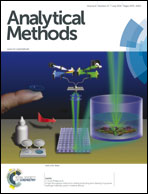In situ SERS interrogation of catalytic reaction on three-dimensional gold nanowire carpeted polycarbonate membranes†
Abstract
Direct monitoring of a catalytic process is essential to elucidate the underlying chemical principles and to expedite the design of next generation catalysts. The in situ SERS approach on three-dimensional gold nanowire ensembles was investigated in this study, which have a double role as an optical enhancer for Raman scattering and as a catalytic active center over many chemical reactions. The nanowire cluster was first electrolessly deposited using a porous polymer template, producing a SERS-active substrate with massive optical enhancement with an average factor of ∼105. This established system, integrating a heterogeneous catalysis and real-time SERS detection, is assessed by monitoring the catalytic reduction of 4-nitrophenol in the presence of excessive amount of NaBH4, during which the gradual increase of Raman intensity from the signature peak of 4-aminophenol is clearly recorded, implying the successful chemical transformation of gold nanowires. Therefore, this integrated system, synchronizing reaction and detection, is an ideal candidate for the in situ study of catalytic reactions on a relatively large scale as it balances technological and economical advantages.


 Please wait while we load your content...
Please wait while we load your content...